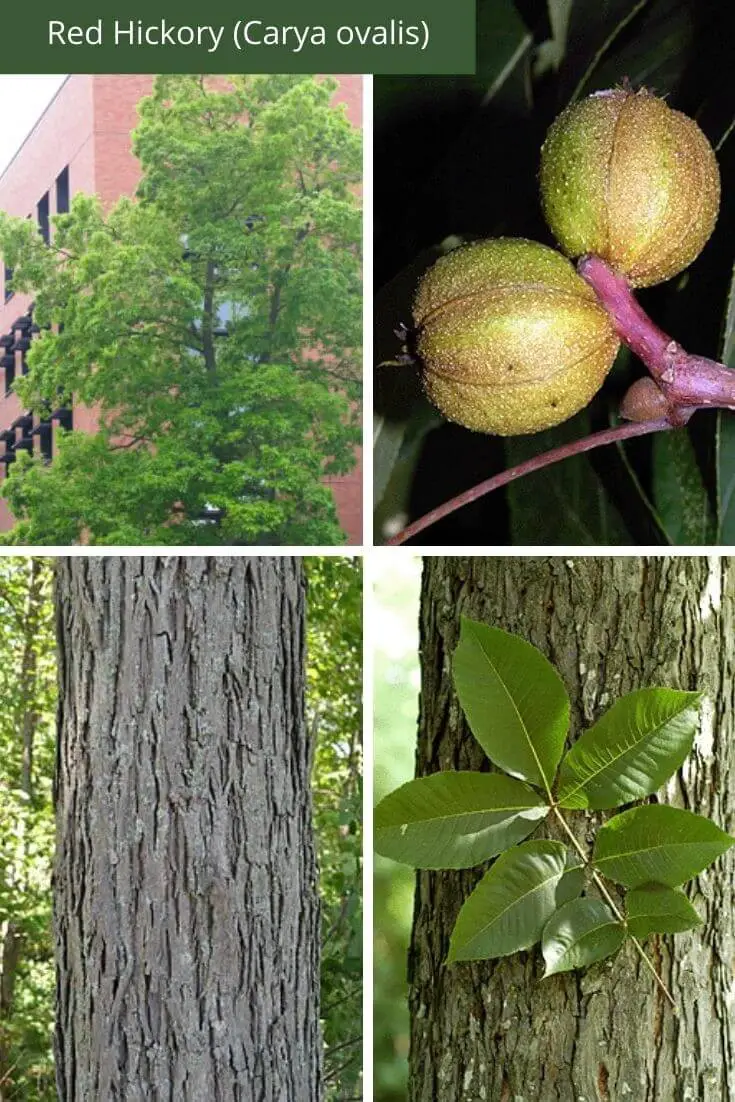21 Types Of Vines With Beautiful Purple Flowers (With Pictures)
Do you have a green thumb and love adding a pop of color to your outdoor space? Look no further than these stunning vines with beautiful purple flowers! From classic climbers to exotic blooms, we’ve got 21 gorgeous options that are sure to brighten up any area. Whether you’re a seasoned gardener or just starting out, this list has something for everyone.
From the delicate charm of Clematis to the vibrant displays of Bougainvillea Vine, these purple flowering vines are sure to captivate and inspire. And if you’re looking for more than just a pretty face, many of these options also offer unique textures, scents, and even edible treats.
So go ahead, get creative, and let the beauty of nature bloom in your own backyard! If you have any questions or want to learn more about a specific vine, feel free to reach out and we’ll do our best to help.
Vines With Beautiful Purple Flowers
Bittersweet Nightshade (Solanum dulcamara).
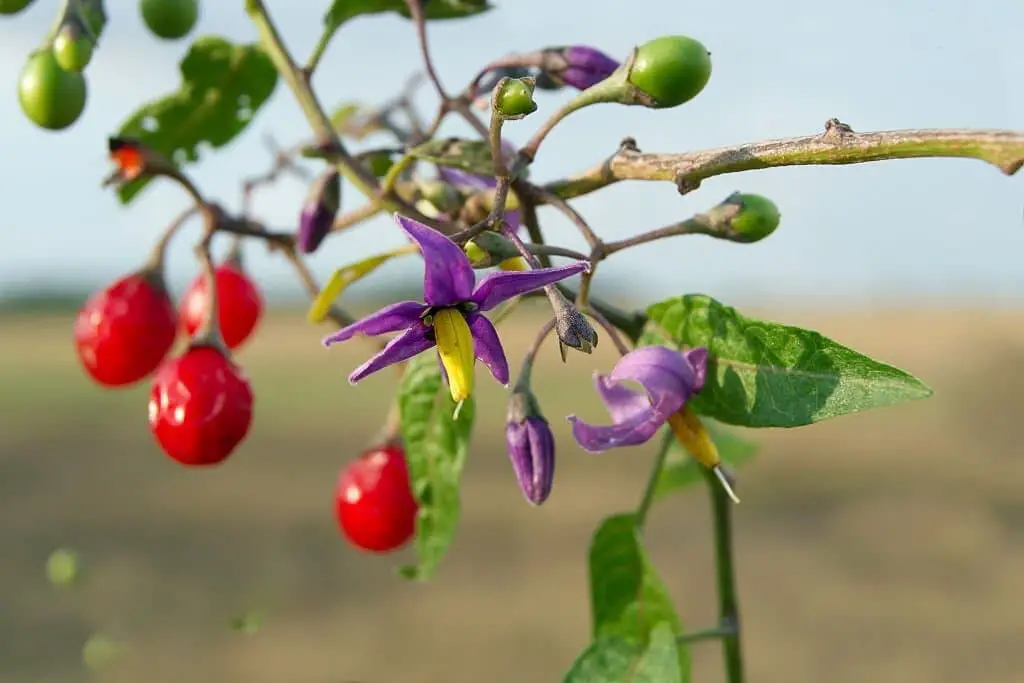
Bittersweet nightshade, a climbing vine adorned with vibrant purple blooms, may appear charming, but it’s essential to recognize its sinister side. Native to Europe and Asia, this invasive species has made its way to North America, where it poses a significant threat to both humans and animals. The plant’s toxic nature means that even the slightest ingestion can have devastating consequences.
What appears beautiful on the surface is actually a ticking time bomb.
All parts of bittersweet nightshade are poisonous, capable of causing severe health issues with just a small exposure. Solanine, a particularly potent toxin, can lead to stomach cramps, vomiting, diarrhea, and in extreme cases, even paralysis and death.
If you encounter this unwelcome visitor in your area, it’s crucial to take action. Remove the plant immediately, especially if you have children or pets that might be enticed by its attractive flowers.
In the event of accidental contact, ensure thorough hand washing and avoid touching sensitive areas like your face and eyes.
Blue Sky Vine (Thunbergia grandiflora).
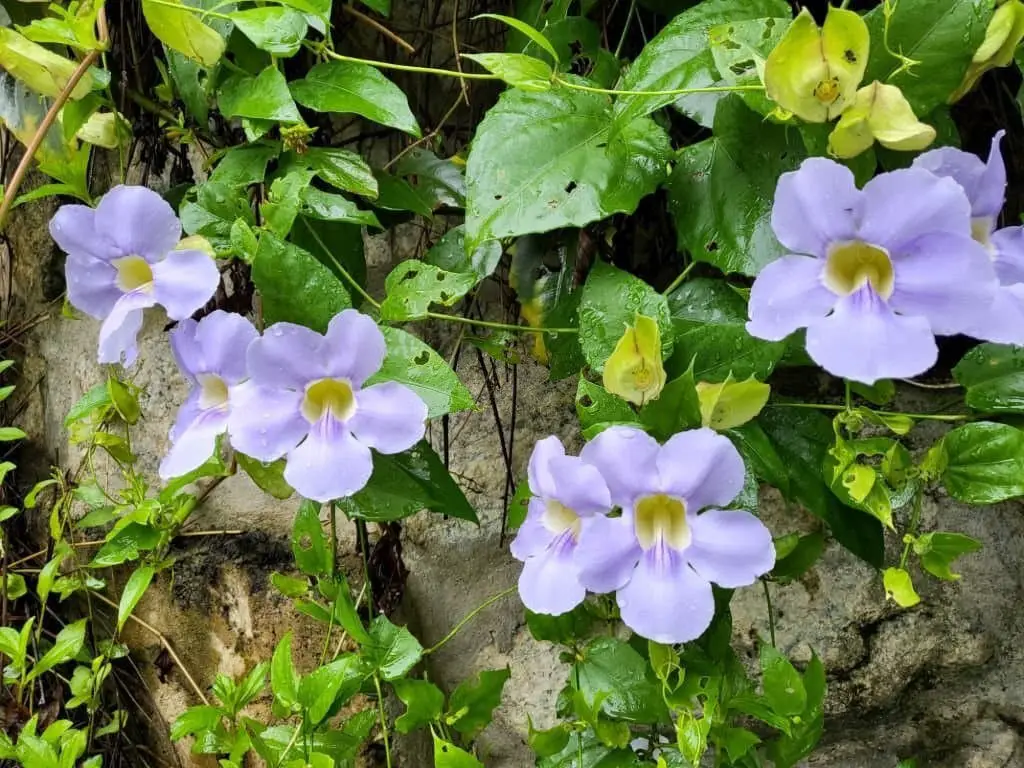
The Blue Sky Vine is a tropical evergreen plant that boasts stunning purple flowers. Reaching lengths of up to 30 feet, this vigorous vine originates from Africa and thrives in temperate climates. With a blooming period spanning spring to fall, the vines produce delicate, two-inch diameter blooms featuring five petals. While it’s a rapid-growing species, caution is advised when introducing it to new environments, as it can become invasive in certain areas.
The Blue Sky Vine tolerates a wide range of soil types and performs well in both full sun and partial shade. Its versatility makes it an excellent choice for covering fences, trellises, or arbors, while also serving as a reliable ground cover option. Propagation is possible through seed dispersal or stem cuttings.
Boston Ivy (Parthenocissus tricuspidata).
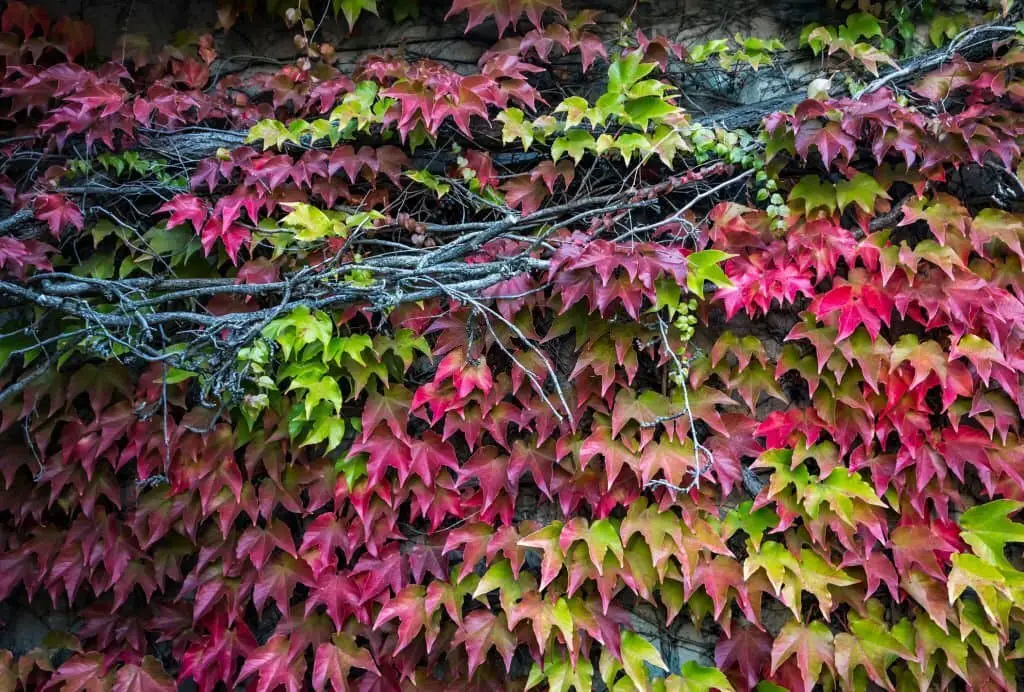
Boston ivy, also known as Parthenocissus tricuspidata, is an excellent choice for covering vertical spaces like walls, fences, and trellises. Its dark green, glossy leaves are composed of three pointed leaflets that provide a beautiful backdrop for the vibrant red foliage that emerges in late summer and early fall. The inconspicuous flowers give way to clusters of blue-black berries that attract birds. This vigorous plant thrives on slopes, making it an effective solution for erosion control.
Boston ivy is not a true ivy, despite sharing similar growth habits, and is native to China and Japan. However, it has naturalized in the eastern United States and remains a popular choice for covering buildings due to its ability to cling to surfaces with tiny rootlets. As a deciduous plant, Boston ivy will shed its leaves during the winter months.
Bougainvillea Vine.
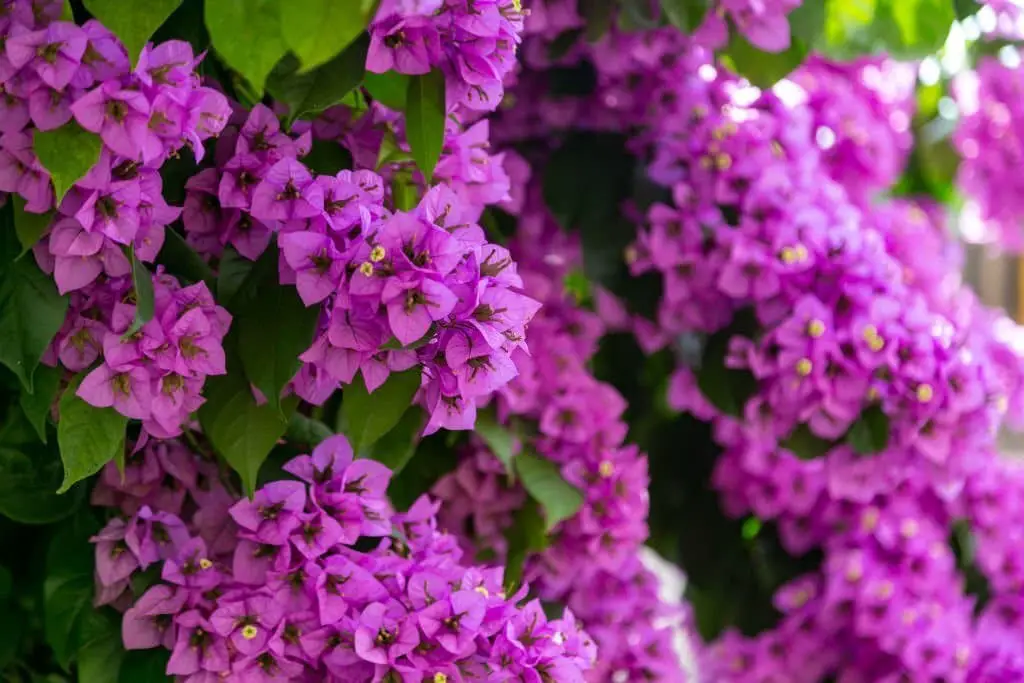
The Bougainvillea Vine is a true showstopper, boasting stunning flowers that showcase a vibrant palette of deep purple and lavender hues, accompanied by delicate shapes. The plant’s dark green leaves are equally impressive, boasting a glossy finish that adds to its overall appeal. As an evergreen vine, it maintains its foliage year-round, growing up to 30 feet in length at an impressive pace.
Native to Brazil, this versatile plant has spread to other parts of the world, making it a popular choice for gardeners seeking a fast-growing, beautiful addition to their outdoor spaces.
Butterfly Pea (Centrosema molle).

Butterfly pea is an annual vine that thrives in tropical climates, reaching up to 20 feet in height as it twines around other plants. Its compound leaves are a defining feature, composed of three to five oval-shaped leaflets arranged alternately along the stem. The plant’s striking purple flowers are a sight to behold, featuring five petals and blooming in clusters at the leaf axils. Each flower cluster is accompanied by a dry, woody pod containing several seeds.
Native to tropical America, butterfly pea has been introduced to other regions, including South East Asia and Africa, where it has been used for centuries in traditional folk medicine. Its purported anti-inflammatory, analgesic, and diuretic properties have made it a sought-after remedy. But the plant’s uses extend beyond medicine – its blue pigment makes it a popular food colorant.
In Thailand and Laos, butterfly pea tea is a beloved beverage, typically prepared by infusing dried flowers in hot water.
Chocolate Vine (Akebia quinata).
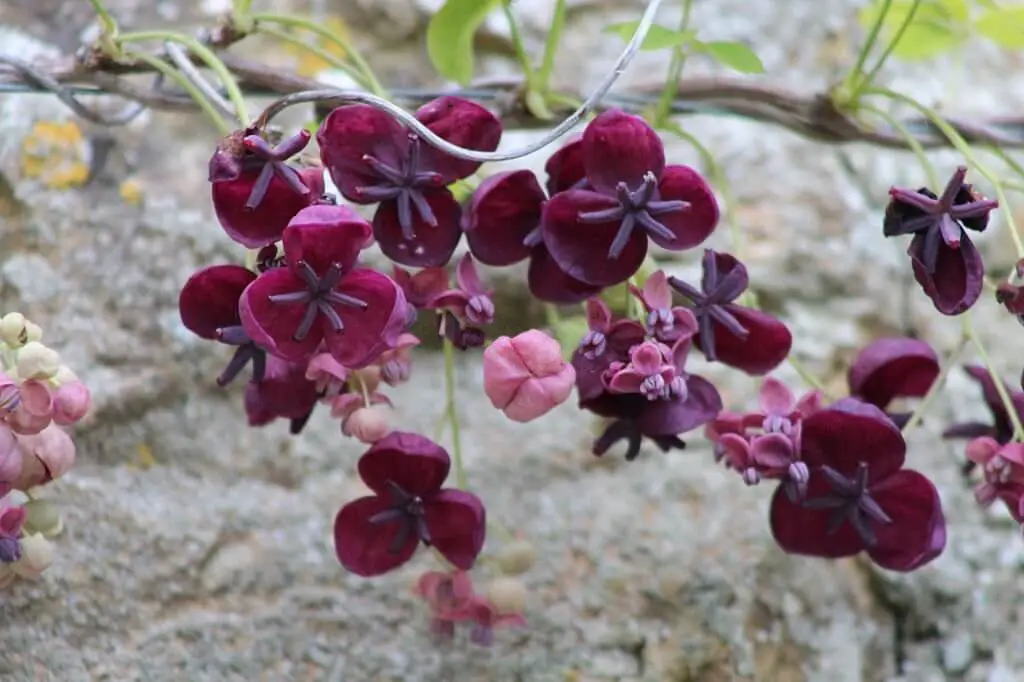
The Chocolate Vine is a rapidly growing plant that can stretch up to 30 feet in length. Its leaves display a unique arrangement, with ovate shapes and serrated edges. The flowers are small and purplish-brown, clustered together in groups of three. A notable feature is the edible, dark purple berry that’s roughly the size of a grape. Native to China and Japan, this plant has been introduced to North America, Europe, and Australia.
Its adaptability makes it an excellent choice for various applications – as a ground cover, climbing vine, or shrub. This plant thrives in full sun to partial shade, withstanding a broad range of soil conditions. Propagation is possible through seed, cuttings, or division. Overall, the Chocolate Vine is an outstanding option for those seeking a fast-growing, attractive, and versatile addition to their outdoor space.
Clematis.
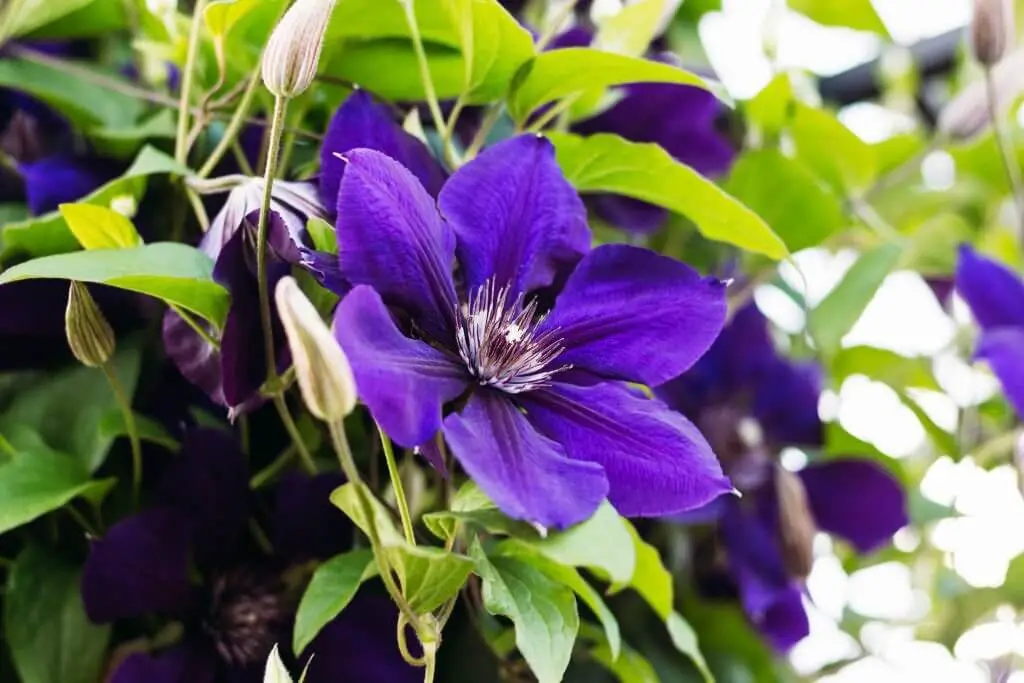
With its stunning purple blooms, clematis is a climbing vine that has won my heart. But what makes this beauty truly special? For starters, it’s part of the Ranunculaceae family, which includes around 300 species within the buttercup genus. It’s no surprise then that gardeners have been enamored with clematis since the early 19th century, when its hybrids first started popping up in gardens.
Native to Asia and Europe, with a small but significant presence in North America, clematis vines are known for their rapid growth and ability to quickly cover trellises or fences. While they thrive in full sun, they’re also surprisingly adaptable and can tolerate partial shade. And let’s not forget the pièce de résistance: those show-stopping flowers that burst forth from early summer to fall, coming in a dazzling array of colors including purple, blue, red, pink, and white.
Climbing Fuchsia.
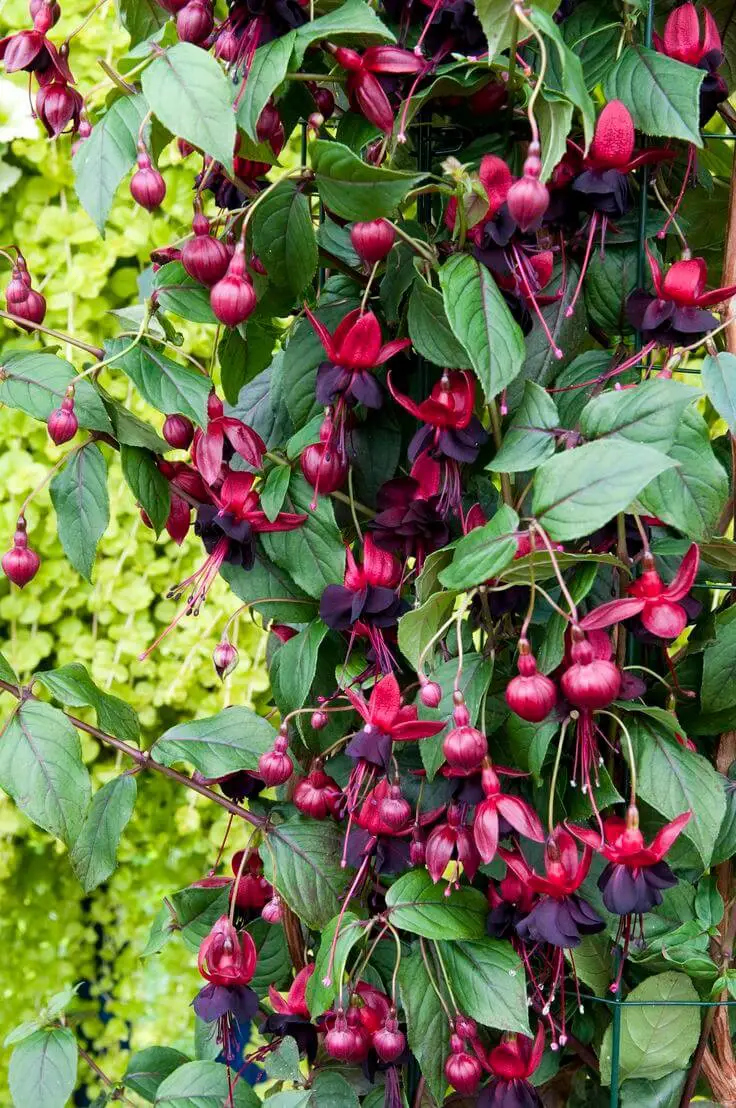
The stunning Climbing Fuchsia (Fuchsia procumbens) is an attractive vine that boasts vibrant purple flowers. Its natural habitat spans Mexico and Central America, although it has been successfully introduced to many other regions worldwide. This climbing vine is a fantastic choice for gardeners seeking to inject color and visual appeal into their outdoor spaces.
The eye-catching blooms are highly effective at attracting hummingbirds and other pollinators, making them a valuable addition to any garden. Climbing Fuchsia is also relatively low-maintenance when it comes to cultivation. It thrives in conditions that range from full sun to partial shade, accompanied by well-drained soil. While it can tolerate drought, the vine will produce its most vibrant flowers if provided with regular watering during the growing season.
Climbing Nasturtium (Tropaeolum ‘Purple Emperor’).
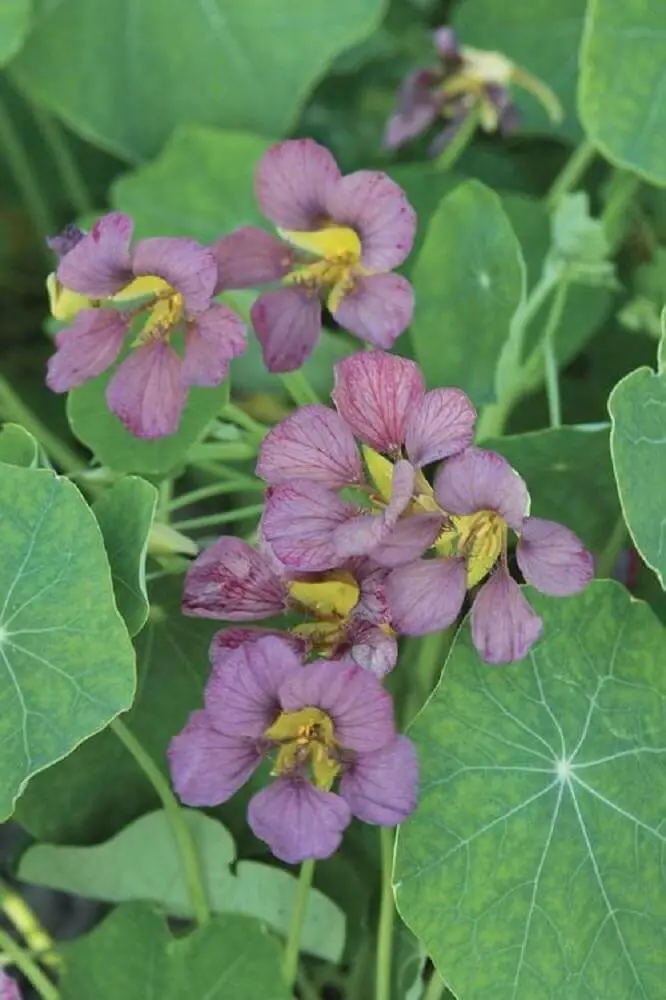
A standout among the lovely climbing vines is the Nasturtium variety boasting deep purple blooms and darker green leaves. Its rapid growth rate makes it an ideal choice for swiftly covering unappealing walls or fences, transforming them into a stunning display of color and foliage.
Dutchman’s Pipe (Aristolochia elegans).
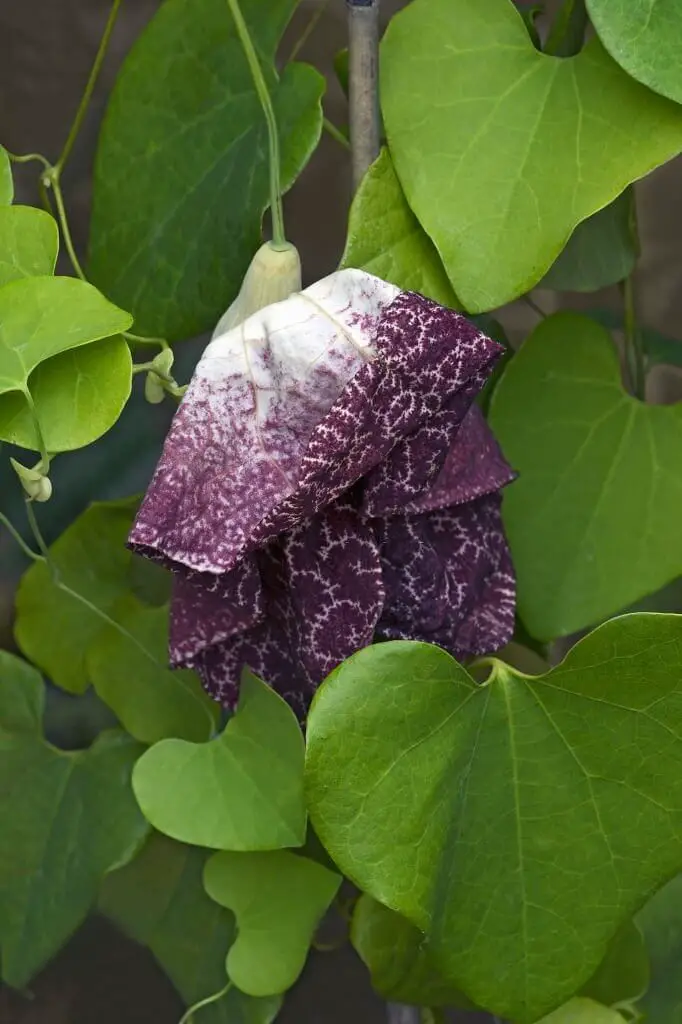
Dutchman’s pipe, a stunning climbing vine, boasts vibrant purple blooms with tube-shaped structures featuring yellowish-green centers. These summer-blooming flowers attract bees and butterflies, making them a delight for any garden. The dark green, heart-shaped leaves add to the plant’s charm. Native to South America, Dutchman’s pipe has been introduced to various regions worldwide and thrives as an evergreen vine, growing up to 20 feet (six meters) in length.
Its fast growth rate enables it to quickly cover a trellis or fence, ideal for creating lush greenery. While it prefers full sun, Dutchman’s pipe can tolerate partial shade. As it matures, the plant exhibits moderate drought tolerance but requires well-drained soil, as it dislikes wet conditions. The vine is not finicky about soil type, preferring slightly acidic to neutral pH levels. Its low-maintenance nature means minimal fertilizer application is necessary.
For those in areas where Dutchman’s pipe is not winter-hardy, container growth and indoor protection during the cold season are viable options.
Garlic Vine (Mansoa alliacea).
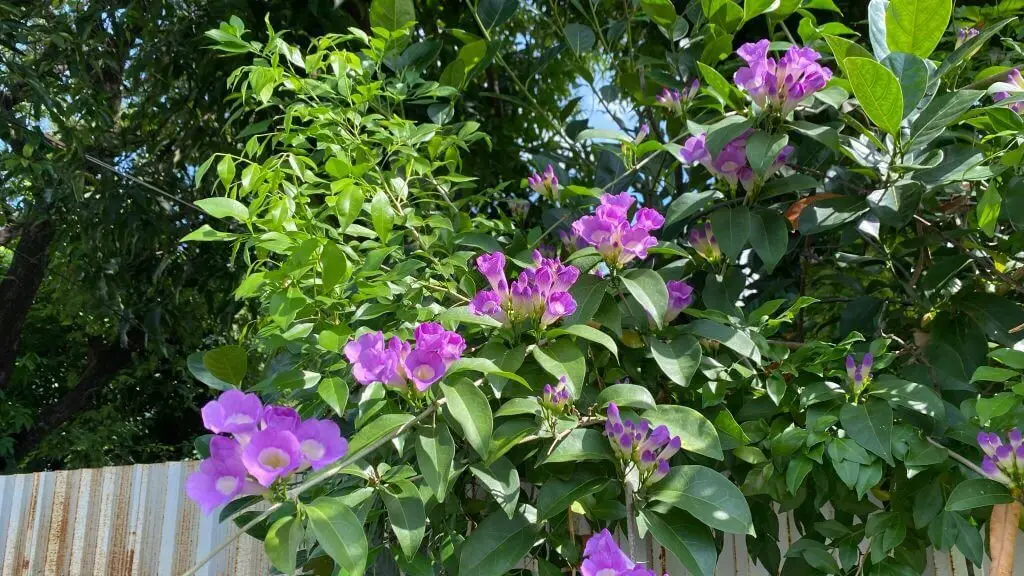
The garlic vine, native to Central and South America, has been a popular choice for ornamental purposes in its native regions. Its leaves possess an unexpected characteristic – when crushed, they release a pungent aroma reminiscent of garlic. This unique feature has led to the plant’s common name. The garlic vine is a remarkable climber, capable of growing up to 30 feet in length as it twines around supports or sprawls across surfaces.
Moreover, its small white blooms are abundant throughout the year, adding a touch of elegance to any setting. As an added bonus, this fast-growing plant is relatively low-maintenance, making it an attractive option for gardeners of all skill levels.
Hyacinth Bean Vine (Lablab purpureus).

The purple-flowering vine boasts impressive growth habits, sprawling up to 30 feet in length. Its fragrant flowers are arranged in clusters, filling the air with a sweet aroma. Native to Africa and Asia, this versatile plant has been introduced to the Americas, where it thrives as an ornamental species. However, its adaptability also makes it a popular choice for cover cropping and green manuring.
As with any invasive species, it’s crucial to consult local authorities before planting, ensuring responsible cultivation and minimizing potential environmental impacts.
Japanese Honeysuckle (Lonicera japonica ‘Purpurea’).
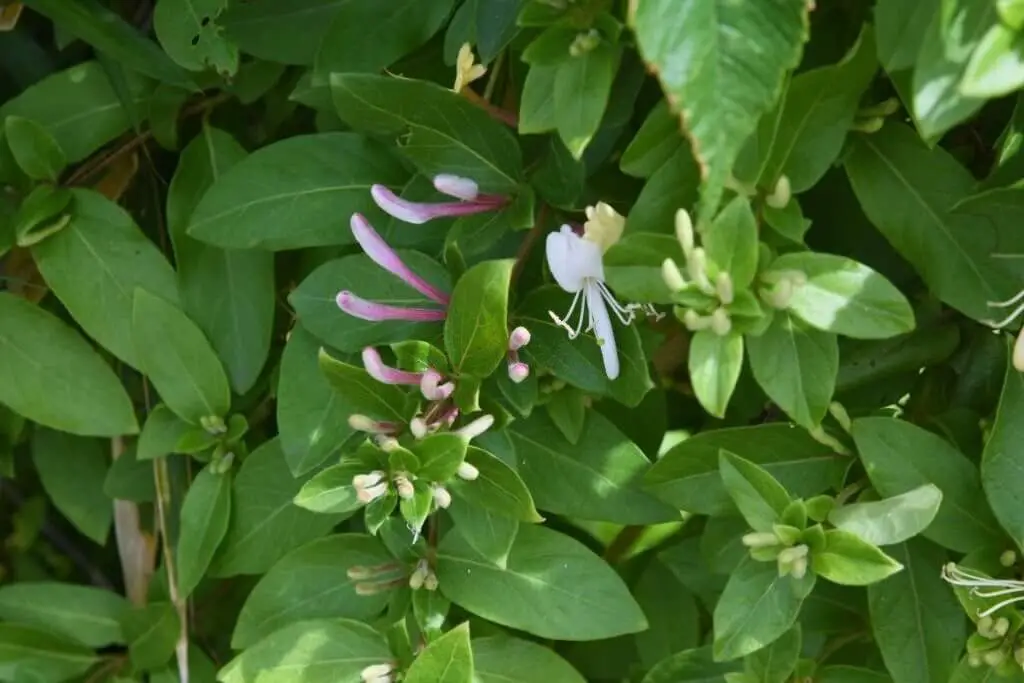
Japanese honeysuckle, a stunning flowering vine, boasts lovely purple blooms and thrives with impressive vigor. Its dense foliage habit allows it to rapidly cover large areas, making it an ideal choice for concealing unsightly walls or fences. As an evergreen vine, Japanese honeysuckle maintains its lush leaves year-round, providing a verdant backdrop for your garden.
Beyond its aesthetic appeal, this plant serves as a vital food source for pollinators like bees and butterflies, drawing wildlife to your outdoor space. If you’re seeking a flowering vine that injects vibrancy and allure into your garden, Japanese honeysuckle is certainly a contender worth exploring.
Lavender Trumpet Vine (Clytostoma callistegioides).

Native to the Andes mountains of South America, lavender trumpet vine is renowned for its impressive growth habits, stretching up to 30 feet in length and producing showy clusters of lavender flowers reaching six inches long. Also known as purple trumpet creeper or lavender creeper, this versatile plant thrives under full sun to partial shade conditions, exceling in well-drained soil.
Lavender trumpet vine can be easily propagated through seeds or stem cuttings, making it an attractive option for gardeners seeking a fast-growing, evergreen vine that’s low maintenance and easy to care for.
Morning Glory (Ipomoea indica).
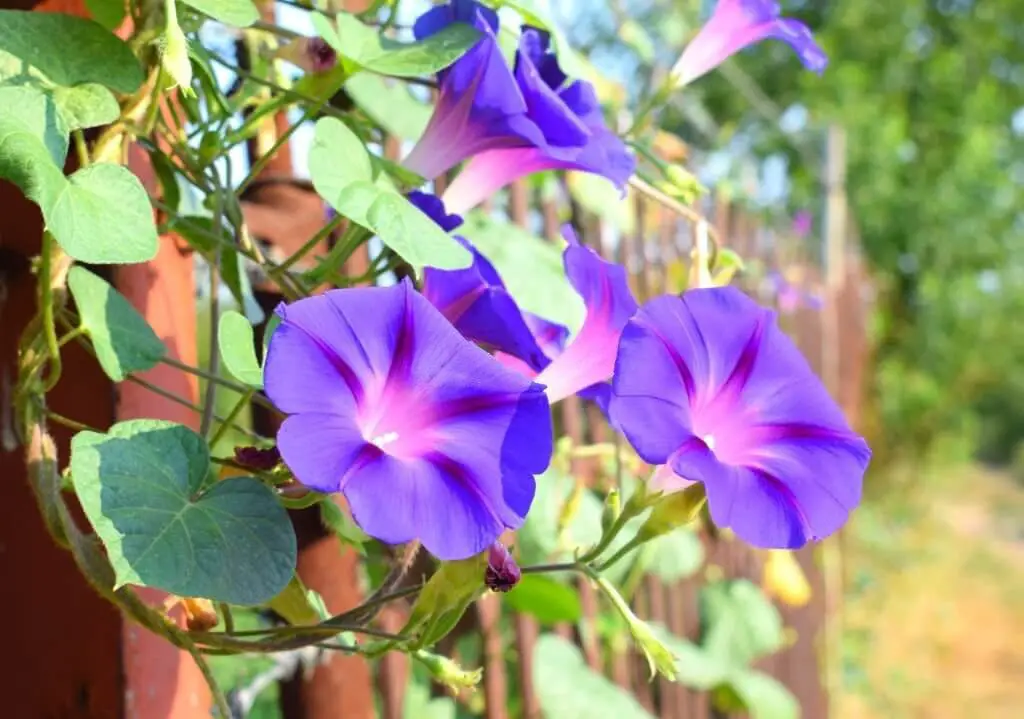
Morning glory, a breathtakingly beautiful climbing vine, is renowned for its stunning purple flowers that boast a sweet fragrance. These trumpet-shaped blooms are quite large and make a captivating sight. While native to tropical America, morning glory has been introduced to various regions globally. In some areas, it’s considered an invasive species due to its rapid spread. The vines themselves can reach lengths of up to 30 feet, thriving in sunny spots with well-drained soil.
For propagation, seeds or cuttings can be used to establish new plants, making morning glory a versatile and attractive addition to any garden.
Passion Vine (Passiflora).

Passion vine is an awe-inspiring, rapid-growing climber that can swiftly envelop an arbor, trellis or fence with its vigorous vines and large, shiny leaves of a deep green hue. The flowers are truly breathtaking, boasting purple petals and bright yellow stamens. Interestingly, this striking vine hails from South America and is closely related to the edible passion fruit.
One of the joys of cultivating passion vine is that it’s remarkably easy to grow, and can be started from seed, cuttings or divisions. As an annual vine, it will typically only thrive for a single growing season. However, in certain regions, the vines may successfully overwinter, resulting in flowers the following spring. Passion vine is adaptable to both full sun and partial shade conditions, and prefers well-drained soil.
Once established, the vines can tolerate drought, but will flourish with regular watering, producing an abundance of vibrant blooms. This stunning addition to any garden is sure to attract a variety of pollinators, including bees, butterflies and hummingbirds. Additionally, the fragrant flowers make for lovely additions to cut flower arrangements.
Purple Vining Roses.
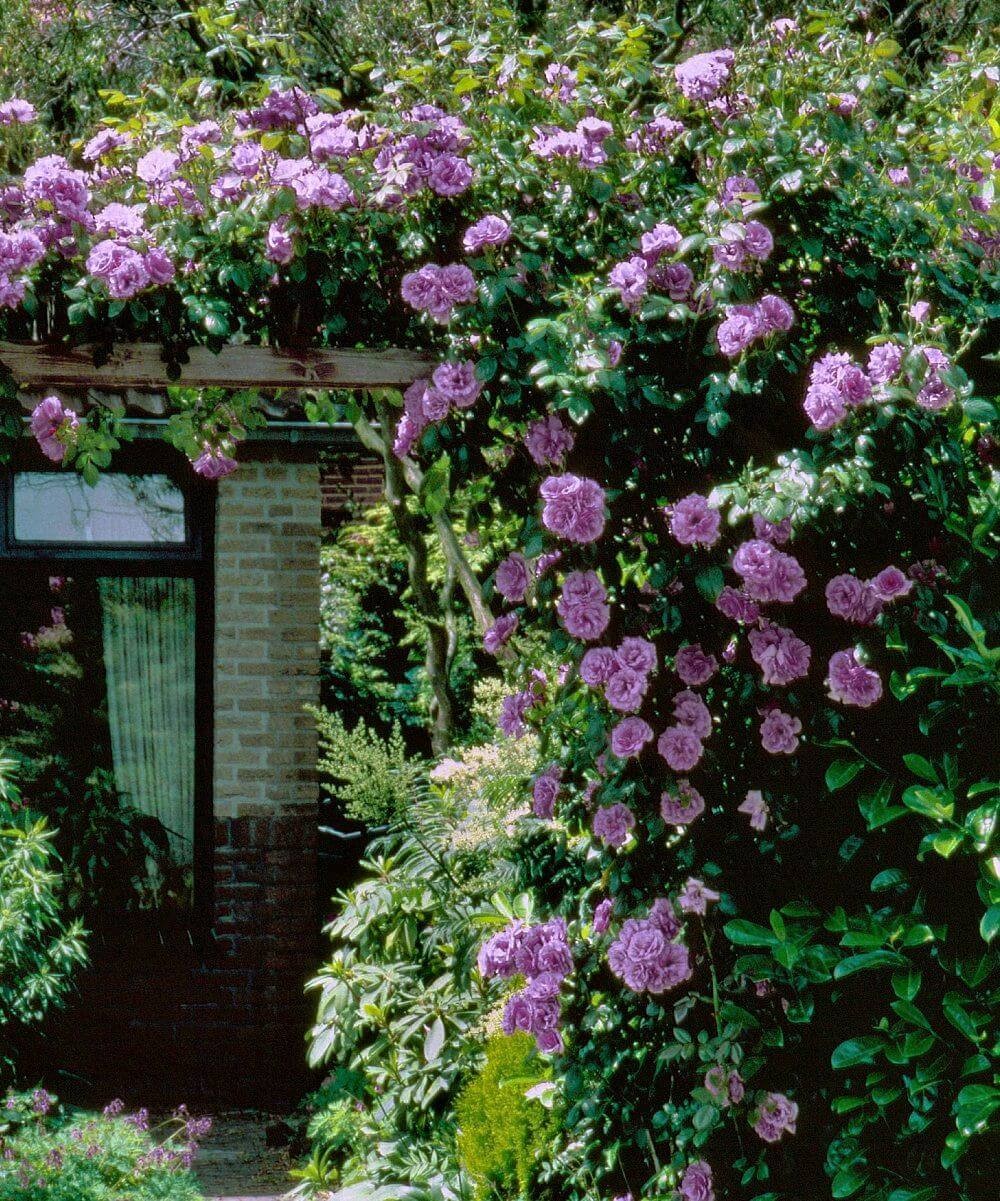
While the phrase ‘a rose by any other name would smell as sweet’ may be true for traditional roses, it’s especially apt when describing vines with stunning purple flowers. These climbing roses are a sight to behold, capable of growing up to 15 feet in length and boasting large, deep green leaves and sturdy stems adorned with thorns. The real pièce de résistance, however, is the vibrant violet hue of the blooms themselves, which exude a powerful fragrance that’s simply irresistible.
Whether used to add a pop of color and scent to a garden or as a show-stopping addition to any bouquet, these extraordinary roses are sure to impress.
Rocktrumpet (Mandevilla Vine).
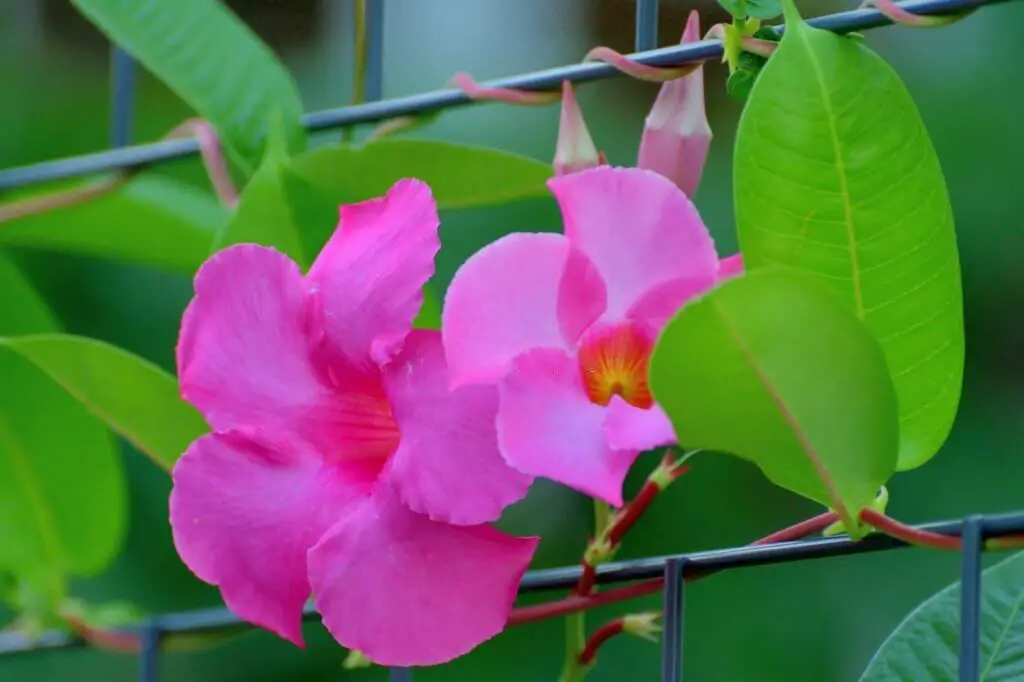
Native to the tropical and subtropical regions of the Americas, Rocktrumpet is a genus of evergreen, perennial flowering plants that bear a rich history. The name Rocktrumpet pays homage to Henry Mandeville, an English diplomat and travel writer who collected these plants in South America during his expeditions. These vigorous vines can grow up to 30 feet in length, featuring glossy, dark green leaves that provide a stunning backdrop for the showstopping trumpet-shaped flowers.
Blooming in shades of pink, red, purple, or white, Rocktrumpet vines are a sight to behold. Notably, they exhibit remarkable heat-tolerance and drought-resistance, making them an ideal choice for hot, dry climates where other plants may struggle to thrive.
Sweet Pea (Lathyrus odoratus).
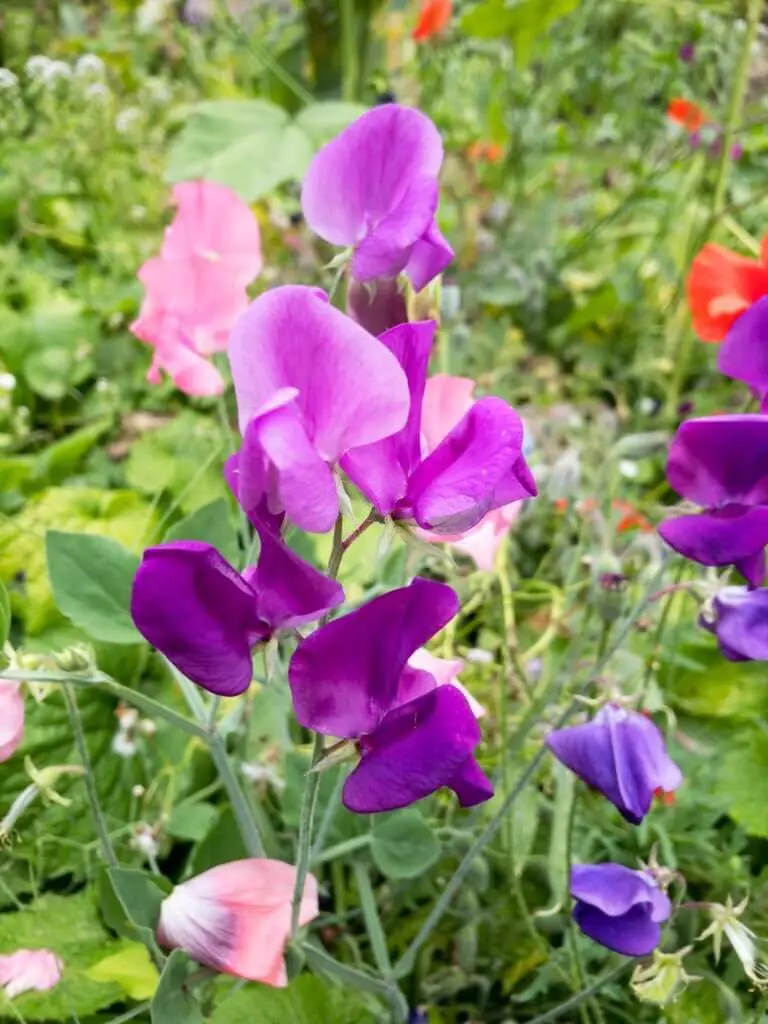
Native to Sicily, southern Italy, and Greece, the sweet pea (a perennial climber in the legume family Fabaceae) has been cultivated since the 16th century for its showy flowers that bloom in racemes. Today, it’s a popular ornamental plant grown worldwide in gardens. Over time, many cultivated varieties have emerged, featuring a kaleidoscope of colors including blue, pink, purple, red, and white.
Notably, the sweet pea’s delicate fragrance has made it a sought-after choice for floristry arrangements. The plant itself is a vigorous climber that can reach heights of up to four feet, boasting dark green leaves and an array of flower hues, with purple being its most iconic shade – although pink, red, white, and blue varieties are also readily available.
Twining Snapdragon (Maurandella antirrhiniflora)
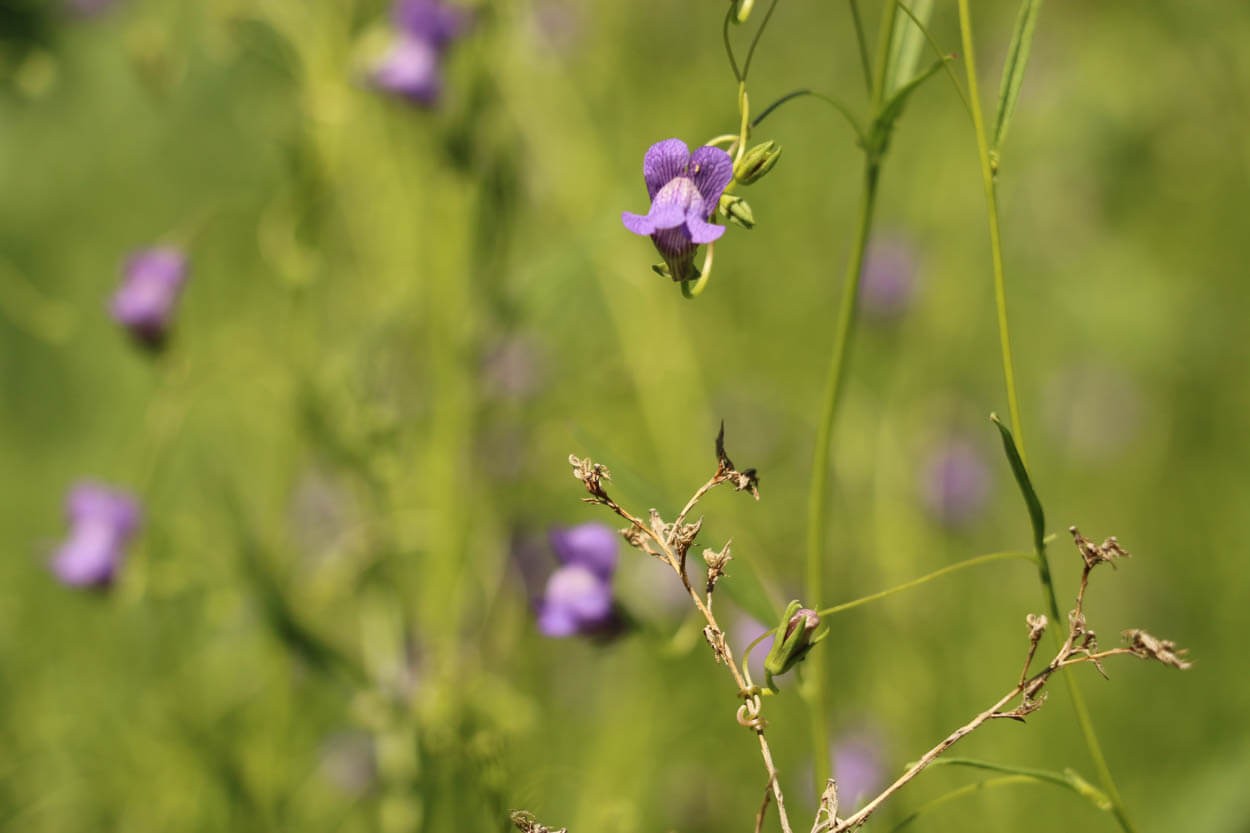
The twining snapdragon, a native European climber, boasts stunning deep purple flowers with a sweet fragrance. Its versatility makes it an ideal choice for container gardens or outdoor landscaping. As a member of the Scrophulariaceae family, which includes foxgloves and penstemons, this herbaceous perennial vine can reach lengths of up to six feet. Its lanceolate leaves, featuring serrated edges, are arranged in opposite pairs along the stem.
The flowers cluster in twos to six, showcasing a striking white throat amidst their deep purple hue, blooming from June to August. A low-maintenance plant, it thrives in full sun or partial shade and can tolerate a range of soil types. Whether used as a container garden feature, groundcover, or incorporated into floral arrangements, the twining snapdragon is sure to delight.
Wisteria Vine.
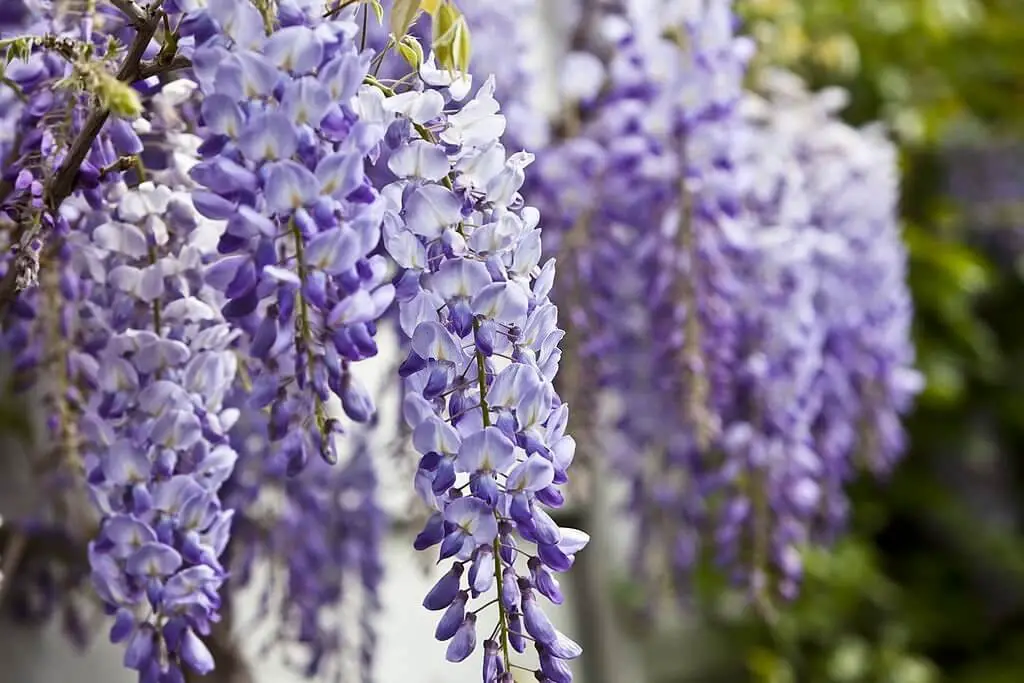
Wisteria is a legume family member that thrives in China, Japan, Korea, and parts of the Eastern United States. This invasive species can be incredibly aggressive, suffocating other plants beneath its robust, twining vines. The plant’s crowning glory is its stunning floral displays, which emit a sweet fragrance and dangle in long, cascading clusters. Wisteria blooms annually in the spring, preceding the development of brown seed pods that stretch approximately six inches in length.
As a deciduous vine, wisteria sheds its leaves with the onset of fall. Its vines can grow quite lengthy, reaching up to 30 feet in length, and are characterized by their remarkable strength and thickness. This makes it a significant challenge to remove them if they become problematic.
FAQs
What is a mauve vine called?
Mauve vines, a type of flowering plant, thrive in wooded areas, showcasing their unique characteristics as either annual or perennial species. Their ornamental value is undeniable, making them a popular choice for gardeners seeking to add a touch of elegance. The standout feature of mauve vines lies in their clusters of small, rich purple flowers that bloom abundantly. Leaves on these plants are typically dark green and glossy, providing a striking contrast to the delicate blossoms.
With a growth potential reaching up to 30 feet in length, mauve vines can add a dramatic flair to any landscape. Typically found in the eastern United States, their presence is often marked by the lush woodlands they inhabit.
What kind of Ivy has purple flowers?
For those seeking a ravishing sight of purple blooms, the world of ivy offers a delightful surprise. Several varieties of this versatile plant boast stunning purple flowers, making it an attractive option for garden enthusiasts and florists alike. Among the most sought-after types are the Algerian ivy (Hedera canariensis), the Persian ivy (Hedera colchica), and the Purple Passion ivy (Glechoma hederacea).
These flowering ivies not only add a pop of color to any setting but also provide a charming display of nature’s splendor. For more information on the diverse range of ivy plants, be sure to check out our related article 24+ Types Of Ivy Plants With Pictures.
Does Poison ivy have purple flowers?
While it’s a common myth that poison ivy has purple flowers, the reality is quite different. The plant’s tiny, inconspicuous blooms are actually a pale green hue and appear in clusters. As a woody vine, poison ivy is adept at scaling trees, fences, and other surfaces to claim its territory. One of its most distinctive features is the arrangement of its three shiny, dark green leaves on the stem – an alternating pattern that sets it apart from other plants.
Poison ivy can be found thriving in a variety of environments, including woodlands, open fields, and even domestic gardens.
What is the name of a purple flowering vine?
Wisteria, the majestic flowering plant, belongs to the legume family, Fabaceae. Its woody, climbing vines can grow up to 30 meters in length, making them a stunning sight when in bloom. The real showstopper, however, is the fragrance of its pendulous racemes of flowers, which are at their best during springtime.
Conclusion
Incorporating vines with purple flowers into your garden or home can add an undeniable touch of sophistication and allure. With their unique, exotic beauty, these vines are not only easy to care for but also capable of thriving for many years when properly maintained. As a result, they have the potential to elevate any setting, making them an ideal choice for those looking to introduce a little elegance into their outdoor or indoor spaces.
If you’re considering ways to enhance your garden or home’s aesthetic appeal, consider giving vines with purple flowers a chance to flourish.
Related Posts
When ordering flower delivery, the question of tipping your floral courier often arises. To clarify the etiquette surrounding gratuities, it’s essential to understand the value that florists bring to the table. Not only do they arrange beautiful bouquets, but they also handle logistics and ensure timely deliveries.
As you ponder whether to tip your flower delivery person, consider the following: the quality of their service, the complexity of the arrangement, and any additional services provided. In reality, tipping is not mandatory, but it’s a thoughtful gesture that acknowledges the courier’s hard work. On the flip side, if you’re ordering from an online florist or a big-box store, it’s unlikely that your purchase warrants a tip.
Instead, consider leaving feedback or recommending their service to friends and family. In conclusion, tipping flower delivery couriers is not a hard-and-fast rule, but it’s a considerate way to express appreciation for their efforts.




